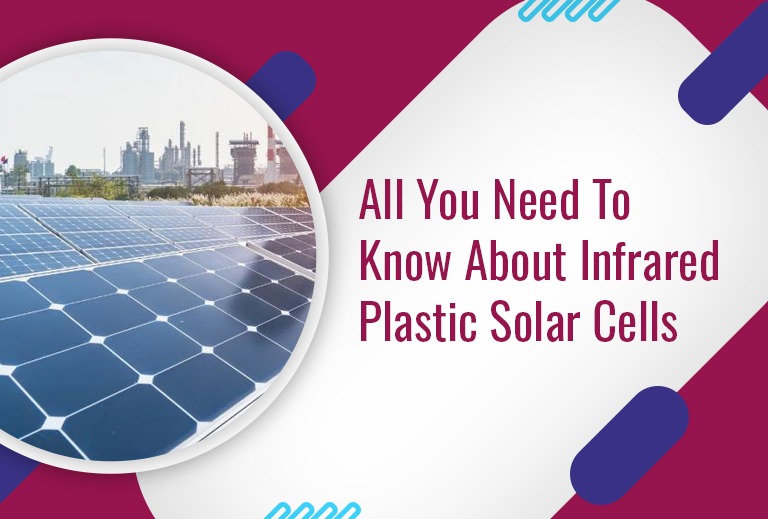All You Need To Know About Infrared Plastic Solar Cells
The past few decades have witnessed many countries making the switch to renewable and cleaner energy sources. Foremost among these sources is solar energy which can harness the power of the sun to drive earth’s energy systems for a billion years. Solar cells are responsible for capturing the sun’s energy and converting it into electricity supply.
Over the years, scientists have been experimenting with solar cells to derive maximum utility. Infrared plastic solar cells are a result of painstaking innovation to ensure that cells can transform solar energy into electricity even on cloudy days with less sunlight.
The Making of Infrared Plastic Solar Cells
An infrared plastic solar cell is created by combining nanoparticles known as quantum dots with polymers capable of detecting solar energy in infrared regions.
A plastic solar cell consists of tiny nanorods that are dispersed in polymer–P3HT (poly-3hexylthiophene). The nanorods are made of cadmium selenide. A layer of nanorods are sandwiched between aluminium-coated electrodes. Conducting plastic will have to be deployed to ensure electrons move through the nanorods.
How do Infrared Plastic Solar Cells Work?
The nanorods present in infrared plastic solar cells serve as wires. During absorption of sunlight belonging to a specific wavelength, the nanorods produce an electron and electron-hole.
The electron generated this way will travel the entire rod’s length until it is collected by the aluminium electrode. The electron-hole is transferred to the plastic and will be passed to the electrode order to create current.
The nanorods will transfer electrons directly to the electrolyte. The capture of energy and its transmission is quick. Its suitability for cloudy and dark days ensure that infrared plastic solar cells are an ideal option for generation of solar power.
Infrared Plastic Solar Cells vs Conventional Solar Cells
Many manufacturers and businesses are making the switch towards infrared plastic solar cells. This is because plastic solar cells are more efficient than conventional solar cells. It has been reported that the comparative efficiency rate for solar cells is 30%.
Conventional solar panels are very bulky. In comparison, infrared plastic solar panels are lightweight and compact. This ensures they can be installed even on delicate roof tops. Also, conventional solar cells are not very capable of capturing solar energy on cloudy days.
Finally, conventional solar cells are mostly associated with large applications. On the other hand, plastic solar cells can be used even on small applications such as window panes.
Want to learn more about infrared plastic solar cells? Why not make your presence felt at Plastivision 2023? It will be held from December 7 to 11, 2023 and will provide you with the gateway to some of the finest innovations in the plastic industry. Meet experts and learn more about how the world of plastic can benefit you through Plastivision 2023.
Leave a Reply Cancel reply
Recent Posts
- Understanding The Materials That Are Used To Build Plastic Toys
- All You Need To Know About Food-grade Plastics
- A Glance At The Materials That Boost The Performance Of Plastics
- Understanding The Importance Of Exploring New Business Opportunities In The Plastic Industry
- Understanding The Importance Of Investing in R&D For The Plastic Industry
Categories
- 3D Printing
- AIPMA
- Automation
- Automobile Sector
- Bio Plastics
- Environment
- Innovations In Recycling
- Latest Innovations
- Molds & Dies
- News
- Packaging Industry
- Plastic
- Plastic Application
- Plastic Industry
- Plastic Market
- Plastic Myths
- Plastic News From The World
- Plastic Packaging
- Plastic Products
- Plastic Recycling
- Plastic Solar Cells
- Plastic Toys
- Plastic Waste
- Plastic World
- Plastics
- Plastics And Their Applications
- Plastics In Agriculture
- Plastics In Healthcare
- Plastics In Medical Industry
- Plasticulture
- Processing Machinery
- Recycling Machines
- Robotics
- Uncategorized
- Virtual Reality
Archives
- November 2023 (3)
- October 2023 (2)
- September 2023 (3)
- August 2023 (3)
- July 2023 (3)
- June 2023 (3)
- May 2023 (2)
- April 2023 (2)
- March 2023 (2)
- February 2023 (2)
- January 2023 (2)
- December 2022 (3)
- November 2022 (1)
- October 2022 (1)
- September 2022 (2)
- August 2022 (1)
- July 2022 (3)
- May 2022 (3)
- March 2022 (2)
- February 2022 (1)
- January 2022 (1)
- September 2021 (2)
- August 2021 (3)
- July 2021 (4)
- June 2021 (4)
- May 2021 (3)
- April 2021 (2)
- March 2021 (4)
- November 2019 (8)
- October 2019 (8)
- September 2019 (8)
- August 2019 (8)
- July 2019 (8)
- June 2019 (8)
- May 2019 (8)
- April 2019 (8)
- March 2019 (8)
- February 2019 (11)
- January 2019 (8)
- December 2018 (8)
- November 2018 (12)
- October 2018 (12)

